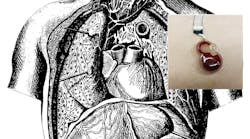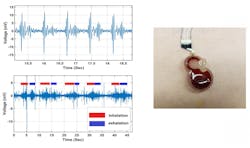The wearable healthcare electronics industry is surging. The upward trend in medical devices that read vital signs, such as biosensors for cardiorespiratory monitoring, is just one area researchers are focusing on in harnessing the potential of sensor technology.
In a new paper, a highly sensitive wearable sensor for cardiorespiratory monitoring is viewed as an option for cardiac patients that require constant monitoring. Consisting of a small, inexpensive mechano-acoustic sensor, the device is based on an electrochemical system involving two ionic forms of iodine, I- and I3-.
The article, published in Applied Physics Letters, describes how a solution containing these electrolyte substances is placed into a small circular cavity that is capped with a thin, flexible diaphragm, allowing detection of subtle movements when placed on a patient’s chest.
The flexible diaphragm converts external signals (small motions from the heartbeat and breathing) to motions of the electrolyte in the narrow channel. As noted by the authors, these motions are then detected electrochemically by the four platinum electrodes that are divided into two anode-cathode pairs and are arranged in the anode-cathode-cathode-anode (ACCA) configuration.
The research team elected to use Ecoflex 00-20, a flexible silicone rubber material for the body of the sensor due to its stretchability, robustness and skin-compatibility. The same material is widely used in medical simulation, orthotics and prosthetics, noted author Yong Xu.
The researchers created a mold for the circular chamber and the associated narrow channel using 3D printing. Next, a solution to create Ecoflex 00-20 was poured into the mold to form the body of the sensor and was also spin-coated on a rapidly rotating disk to produce the thin diaphragm. After the diaphragm and chamber body were bonded together, a syringe was used to fill the chamber with the electrolyte solution.
The device is 28 mm wide and skin-safe so it can be attached directly to the patient’s body. The device was able to detect the heartbeat with high sensitivity. A signal-to-noise ratio of greater than 6:1 (considered good) was achieved, reported the authors.
The device detects respiration in two ways. The first hinges on the sensor’s stretchability; it deforms when the chest contracts and expands during breathing, functioning as a strain sensor. The second is an indirect method that depends on the way the volume of the chest cavity shifts during a breath, modulating the heartbeat signal, which in turn detects changes in the heartbeat.
According to Xu and his co-authors, there is more than one use for the sensor, including the potential to be used for diagnosis of respiratory diseases like COVID-19, which often leads to shortness of breath.
“Symptoms in the early stage of infection could be subtle,” said Xu. “Wearable devices that are capable of accurate detection of subtle respiratory and cardiovascular variation are of great interest, especially during the current pandemic.”


